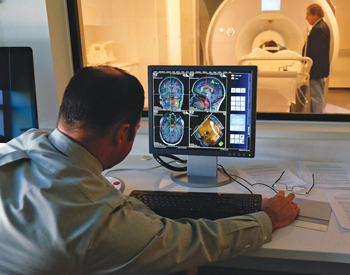
Imagine the Images
A dramatic advance in research capability
OUR UD | They call it a “game changer.” It’s also been dubbed a “mind reader.”
The newly installed $10 million functional magnetic resonance imaging (fMRI) machine, situated in UD’s just-launched Center for Biomedical and Brain Imaging, will ultimately have the ability to help change people’s lives and end their suffering. It has the potential—already realized—to attract top researchers to UD. And it is being called a perfect example of the combined power of public support and private philanthropy to enhance UD’s potential and boost the impact of research in ways that reach far beyond campus.

Funded in part through the generosity of the Unidel Foundation, the 14-ton fMRI is being used to explore the mysteries of (and find solutions to) a variety of vexing problems. UD researchers are enlisting the massive machine’s super-senses to advance their efforts to cure post-traumatic stress disorder in combat veterans, reveal why some teens are more prone to anxiety and mood disorders, help identify effective treatments of spinal injuries and more.
There are even efforts underway to help unlock the mysteries behind some far-more-common human conditions: Like why some people engage in self-destructive and risky behavior such as alcoholism, or whether our “first impressions” of people are really all that reliable.
And many more advances are sure to come.
The machine’s power to take such revelatory steps in research is due to its cutting-edge capabilities. Unlike a typical MRI machine, UD’s new donut-shaped mega-magnet has the power to not only peer into the human body and visualize structures, but to also reveal activity within those organs—neural activity zapping to and fro in the brain, or the interplay between muscles and bones of children with cerebral palsy.
That opens a path for researchers to explore in ways they never have—to even “see” clues into what someone’s thinking, or to determine what neural mechanisms are involved in the decisions people make, or the memories they keep, or how well they learn.
The machine's sophisticated technology is expected to become a magnet that also draws outside researchers eager to capitalize on its potential—making UD an even more prominent leader in 21st century research.
“This type of imaging is critically important, not just for psychology but also for biomedical engineering and health sciences, and more,” said Dawn Elliott, director of UD’s biomedical engineering program. “Having this here will be a big benefit to my research and to many others’.”
Article by Eric Ruth, AS93


